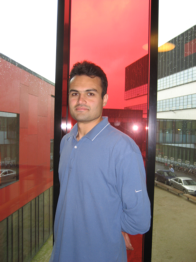Novel spectroscopic techniques in scanning tunneling microscopy: Applications to modified Ge-substrates
Promotion date: 27. August 2010
Promotors: Prof. dr. Harold Zandvliet
Assistant Promotor: Prof. dr. Bene Poelsema
| At the moment, tailoring the structure of nano-scale materials seems to be the most promising strategy finding materials possessing novel properties and applications. In this thesis the focus is on modified Ge-surfaces. By depositing a small amount - up to few monolayers - of material on a clean germanium substrate, the surface exhibits physical properties different from both the clean substrate and the deposited material in its pure form. STM was chosen as the key method in this study. TR‐STM was introduced as well, and it was shown how this method could improve the temporal resolution of STM, up to seven orders of magnitude. Using TR-STM a complex dynamic feature on Pt-modified Ge(001) surfaces was studied. This atomic scale variant of a pinball machine acts like a nano‐mechanical device. It exhibits a variety of dynamic modes, exclusively excited by an external electrical signal. |
What was the central theme of your thesis project?
My aim was to study new physical properties of different modified Ge-surfaces. Many unexpected features and properties have been found on these surfaces.
One example was finding a feature consisting of four atoms, resembling a nano-machine. Two atoms were acting like pivots, the remaining two could revolve around the pivots.
The structure looks like a nano pinball machine. One could operate this machine by regulating the electric current passing through it, provided by a STM tip.
This part of my work attracted lots of media attention. Also it led to a publication in the highly ranked magazine of Nanoletters.
In another case, a new phase, formed by platinum on germanium, showed electronic properties never seen before. Also hydrogen and CuPc adsorption on Germanium surfaces was studied.
Were your pinball findings, more or less, a lucky accident?
In a sense, yes. On the other hand, I also believe that the special research strategy of our group enhances the chance of discovering surprising phenomena. In the Physical Aspects of Nanoelectronics Group - led by Harold Zandvliet - we work in a path-oriented manner, rather than exclusively target-oriented.
If we head up for a far mountain and come across a river, we explore the river first. Then, probably, we end up in the woods and then we may start to explore the woods. In this way, the chance of finding surprises increases significantly. This is not the case for more application-oriented groups, since they stay focused on their target. They become less keen to trace other interesting phenomena they might encounter on their path.
So, you are a true experimentalist.
Yes, our group is an experimental group. Experiments are about real things. However, you need a great deal of theory to understand what is really happening out there.
Before joining this group my study field was materials science. During my PhD I earned a lot of knowledge about solid state physics. Changing my field has extended my horizon significantly and I feel very happy about it.
What are your future plans?
Being a professor in physics one day, leading my own group, is my ultimate goal. But for that I need to build up a strong resume in physics. That takes both challenges and time.
Now I am applying for a research position in an academic environment, favorably in Holland. I am used to living in the Netherlands now. However, if an interesting research position comes across in another country, I will not hesitate to go there. The project is more important than the location.
What, in your opinion, is important for Mesa+ to stay successful in the future?
Organizing research is very complicated. First of all, the institute should conduct a lot of application oriented projects. These projects can benefit the institute and the society in the short term.
Also, the institute should invest in high-quality fundamental research as well. Fundamental research may not have a short term impact on society, past experience shows that the majority of revolutionary ideas are the outcome of fundamental research.
Without having a balance between these two types of research, the institute can not thrive in the course of time.

